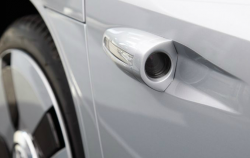
— If you read investigations and recalls announced by the National Highway Traffic Safety Administration (NHTSA,) you'll see many caused by electronic or software problems in the affected vehicles.
Cars are an intricate web of wiring, sensors and software that can fail and cause a trip to the dealer. An average vehicle has about 60 microprocessors and over 10 million lines of software code. And chances are, you'll be forced to visit a dealer for repairs as shade tree mechanics typically don't have the tools to diagnose a problem, let alone fix the mess.
The addition of more electronics and software that can fail doesn't seem to bother automakers or the government. Last month NHTSA announced rear-view cameras will be mandatory on new vehicles starting in 2018, another electronic device to add cost to the car, another device to break down.
That will add another electronic screen for drivers to stare at, unless they are already staring at their MyFord Touch while it malfunctions.
Now automaker Tesla and the Alliance of Automobile Manufacturers (AAM) want another screen and more cameras an option on cars. Tesla and AAM have petitioned NHTSA for permission to replace side mirrors with side-view cameras.
Proponents say replacing mirrors with side-view cameras will offer added safety and improved fuel economy.
AAM claims side-view cameras would improve fuel economy by 3.2 percent by reducing drag on the vehicle. This sounds like a good idea as long as you have the scientific proof to support the claim.
In its petition to NHTSA, AAM said, "By reducing the frontal area of the vehicle, the aerodynamic drag will be reduced and fuel economy will increase." Their source for this statement? A bicycle racer competing in the Tour de France.
AAM says a cyclist "can often be seen getting down low into a crouched position with elbows in, i.e., a more streamlined posture, to reduce their frontal area and thus, their aerodynamic drag."
That sounds impressive, but the better question to ask is how much drag would be reduced on the bike if a simple small mirror was removed?
AAM also used a book from 2005 as their source for the mileage claim, but even the author of the book said everything was an "estimate" of improved fuel economy.
As for added safety benefits of side-view cameras, the petition says using a camera will expand a driver's "field of view" and expose blind spots, something especially helpful to older drivers who have upper mobility problems.
AAM's source material for this claim is a short "article" on a website run by AAA to assist older drivers in choosing a vehicle.
However, while AAA says rear-view (not side-view) cameras might help with neck or shoulder problems, AAA also says this about cameras:
"These systems [cameras] are intended to supplement a driver’s visual checks. They are NOT replacements for mirrors and should not be used as such." - AAA
The petition does say that Tesla has tested side-view cameras during on-road driving and found they have the "potential" to eliminate blind spots.
For the sake of argument, let's say side-view cameras are finally proven to be better than mirrors. Would they be worth it? That's hard to say because the petition doesn't mention a word about what the system would cost the customer.
Another roadblock could be state laws, most of which require vehicles registered in their states be equipped with at least a driver’s side mirror.
And don't expect auto insurance rates to decrease because of rear-view or side-view cameras. Insurance companies will need solid research and proof of decreased claims before adding any camera system to discount programs.




